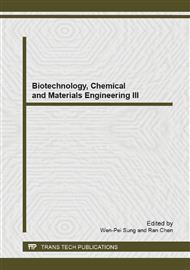p.475
p.481
p.485
p.490
p.494
p.498
p.503
p.507
p.512
Preparation and Performance of Controlled-Release Tablets of Sasanquasaponin-Sodium Alginate-Hydroxypropyl Methyl Cellulose
Abstract:
The controlled-release tablets of sasanquasaponin-sodium alginate-hydroxy-propyl methyl cellulose (SQS-SAL-HPMC) were prepared by using SQS, SAL and HPMC as the main drug and accessories. The effects of the preparation method of the controlled-release powder and the amount of ethanol on release rate respectively were studied. The release rate curve of the data of the prescription of the controlled-release tablets of SQS-SAL-HPMC were fitted as zero order, one order and Higuchi equation. The controlled-release tablet of SQS-SAL-HPMC was characterized by IR techniques. The releasing rate of the controlled-release tablets of SQS-SAL-HPMC are controlled by controlling the preparation method of the controlled-release powder and the amount of ethanol. The controlled- release tablets of SQS-SAL-HPMC release SQS by slowness and constant in 12h. The chemical bonds are formed among SQS, SAL and HPMC.
Info:
Periodical:
Pages:
494-497
Citation:
Online since:
January 2014
Authors:
Price:
Сopyright:
© 2014 Trans Tech Publications Ltd. All Rights Reserved
Share:
Citation:


